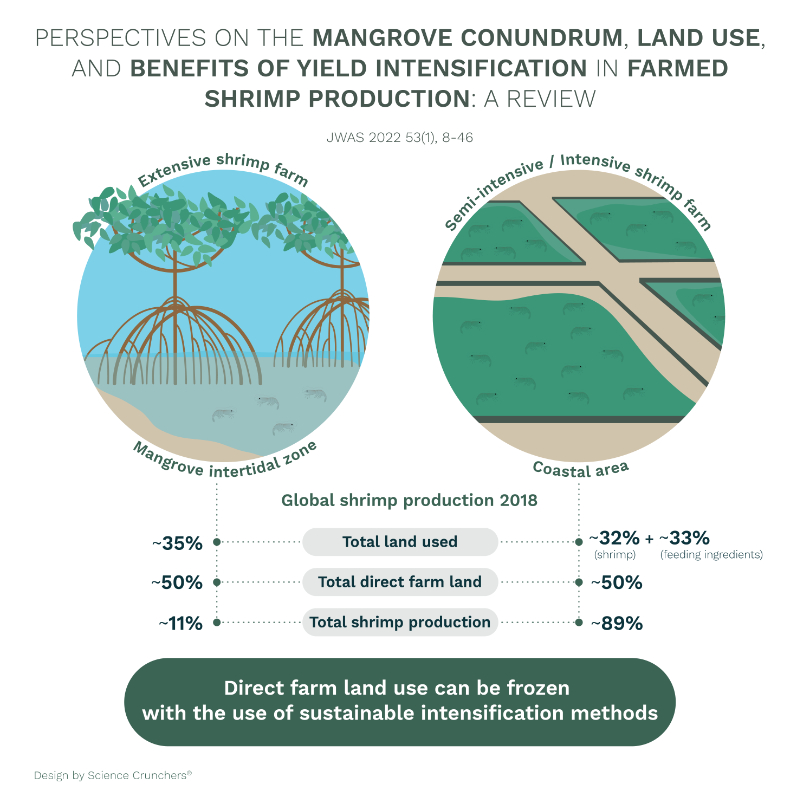Perspectives on the mangrove conundrum, land use and the benefits of yield intensification in farmed shrimp production: a review
Claude E. Boyd, Robert P. Davis, Aaron A. McNevin
Globally, shrimp farms occupied approximately 3.490 million hectares (Mha) of land and operated 2.426 Mha of production ponds in 2018. Extensive shrimp farms used 1.804 Mha of agricultural area (1.377 Mha of production ponds), but produced 11.4% of global shrimp production. . An estimated 1,718 Mha of land was required to produce feed ingredients used in semi-intensive and intensive shrimp farming, bringing the total land use to 5,160 Mha. Extensive production is located in the intertidal zone and much of this land was once or still is in mangrove areas. Expansion of shrimp farms in mangrove areas has slowed. Mangrove areas are inferior sites for shrimp farms, and governments have imposed stricter regulations to protect mangroves. Shrimp farming in mangrove areas is not necessary to meet the global demand for shrimp. Scenarios of increasing global shrimp production without further expansion of shrimp farmed area are presented. But, if the demand for shrimp continues to increase, it will be impossible to freeze the total land footprint of farmed shrimp, as the land needed for food currently roughly equals the direct land use for shrimp farms. Direct land use for farms can be frozen through higher yields from production ponds.
[Full Article]
Controlled spawning and breeding of the sea cucumber, Parastichopus tremulus
Schagerström, E., Christophersen, G., Sunde, J., Bakke, S., Matusse, NR, Dupont, S. and Sundell, KS
The majority of sea cucumber fisheries are overexploited and the first steps towards aquaculture of new species in Europe, where fishing pressure is increasing, are rare. Spawning and larval rearing protocols are essential for the sustainable use of sea cucumber species around the world. Schagerstrom et al. successfully apply established methods to Parastichopus tremulus, a species of great interest in northern Europe. Successful post-oviposition larval development indicates that relatively standard culture protocols with suitable temperature regimes can be applied to this species. Fine-tuning of protocols is suggested, including power and temperature optimization, as well as improved handling.
[Full Article]
Factors Influencing Chinese Consumer Attitudes on Aquatic Product Safety
Dai, Y., Yuan, Y.-M., Yuan, Y., Zhou, Z. and Zhang, H.
Consumer attitudes and consumption patterns are changing rapidly in the world’s largest seafood market, mainland China. Dai et al. show that preference for food safety is overriding necessity among consumers across China. Consideration of the implications for the health of the elderly and the very young is important in this shift in product preference. Meeting current and future consumer demands in China requires a shift towards product safety, potentially at the expense of overall production volume.
[Full Article]
Measurement and analysis of technological progress bias in China’s mariculture industry
Sun, Y., & Ji, J.
Ji et al. in their recent study, apply data envelopment analysis to calculate input-biased technological progress as an index in the mariculture industry in China. The initial development of the industry relied heavily on factor input and scale expansion, classic for extensive development. The authors argue, however, that continued growth requires technological advances and corrected pricing of labor and ecosystem services (in the form of sites). The contribution of technological progress remains too weak and must be dealt with. The authors argue that technological innovation should be encouraged and dependence on resources, including environmental inputs, should be reduced through government intervention. Workers should be remunerated appropriately and product pricing and access costs to mariculture areas should be defined and set accordingly to enable healthy and sustainable development of the industry.
[Full Article]




